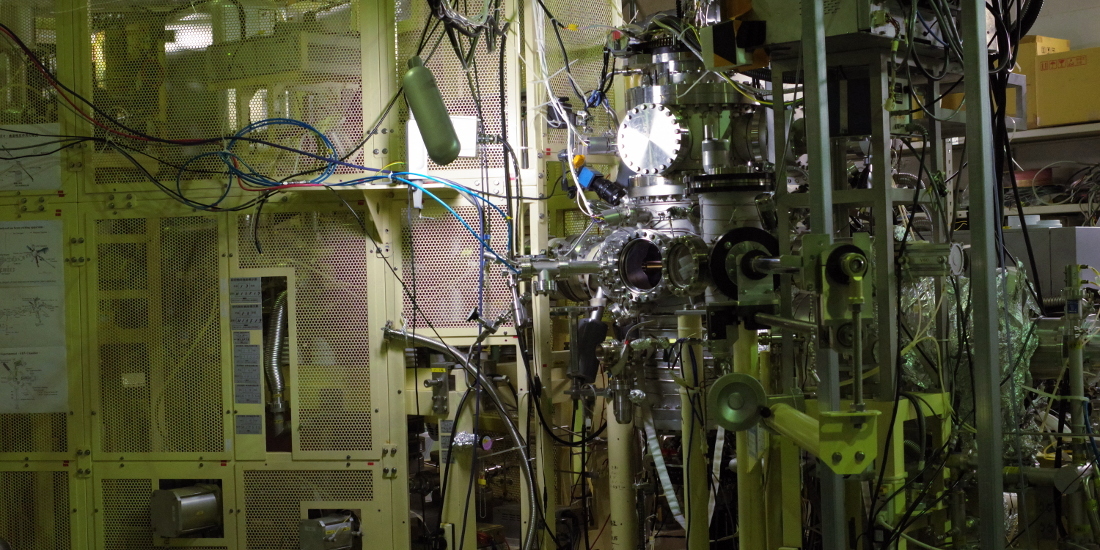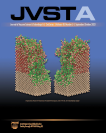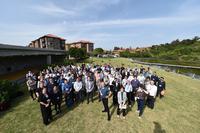Hamaguchi Laboratory

Our recent focus in research is on plasma-material interactions in general, including their industrial applications.
The aim of research is to understand fundamental mechanics of plasma-material interactions under various conditions.
To achieve this, we combine plasma/beam experiments with numerical simulation/modeling.
More specifically our current research topics include
1) etching, deposition, and surface modification processes for micro/nano electronics device manufacturing,
2) surface modification and functionalization of biomaterials by plasmas,
3) processing of water and biological systems by atmospheric-pressure plasmas mainly for applications in plasma medicine and plasma agriculture,
and 4) dynamics and chemical reactions in plasmas under various conditions, including atmospheric-pressure plasmas.
If you are interested in our research, please feel free to contact me.
Satoshi Hamaguchi
Professor, Center for Atomic and Molecular Technologies, Osaka University.
Events & News
- - / -
- The following conferences were held jointly in Okinawa, Japan. See their websites for more information.
-
The 5th Atomic Layer Process (ALP) Workshop will be held in Osaka, Japan (on-site only).
All talks will be given in Japanese.
website
- Lab Hiking: Mt. Ikoma (Osaka & Nara)
- Farewell and Guraduation Party
-
JVST A cover art
 A figure in a paper by Dr. Nicolas Mauchamp and Prof. Satoshi Hamaguchi was adopted as a cover art of JVST A.
A figure in a paper by Dr. Nicolas Mauchamp and Prof. Satoshi Hamaguchi was adopted as a cover art of JVST A.
See here .
.
- We had a lab BBQ party at Expo Park.
- -
-
The 2nd Workshop on Artificial Intelligence in Plasma Science (WAIPS-2) was held in France (on-site and online).
website
- Hanami and Farewell dinner for Erin/Welcome dinner for Sarah
Plasma Seminars
If you are interested in attending the seminars, please contact us.
-
"Production, characterization and prediction of battery performance using machine learning of silicon-based anode thin films for lithium-ion batteries"
Ms. Elif Muslu
Department of Chemistry, Faculty of Arts and Science, Suleyman Demirel University, 32260, Isparta, TurkeyDate: (Mon) 14:30-15:00 (JST)
Location: Main Conference Room (1st floor), Bldg. A12, Suita Campus, Osaka University
Webex Online Conference availableAbstract
Lithium-ion (Li-ion) battery technology is significant for sustainability, reducing carbon dioxide emissions and preventing global warming. Therefore, the most important component of the battery should have a high energy density, stability and long charge/discharge cycle life to increase the performance of the anodes. Instead of graphite with a specific capacity of 372 mAh/g as the most known anode; By using 4200 mAh/g silicon (Si), the energy density of Li-ion batteries can be increased. But, commercial usage of Si anode is limited due to its high electronic resistance and low mechanical stability. For this reason, many battery manufacturers and electric vehicle automotive companies are involved in R&D activities to eliminate the disadvantages of Si anodes and take advantage of their advantageous features.
In this study, various transition metal oxide modified (MeO) (sandwich-like Si/MeO/Si thin film anodes were produced on copper substrate by Radio Frequency (Rf) Magnetic Sputtering method. Si-based thin-film anodes have properties that do not contain any binders, solvents and conductive chemicals that can reduce their specific capacity.
On the other hand, to reduce the excessive time and energy consumption while producing the thin film, it is necessary to develop and use models that can predict some of the characterization outputs of the thin film according to the production parameters. Moreover, the prediction of battery performance analyses (Specific capacity, cycle performance, capacity retention and Coulomb efficiency, discharge capacity, and charge/discharge profiles) is of great importance for the safe and efficient operation of Li-ion batteries, that is why these batteries are complex, time-varying, non-linear electrochemical system and their performance can change with many factors such as charge/discharge current, ageing and temperature changes.
The main aim of this study is to support and compare produced Si-based thin-film anodes and their battery half-cell characterization data and battery performance test studies, and to make their prediction with the help of ML to reduce energy, material, and time consumption.Read More
-
"Chitosan-acrylic acid hydrogel preparation and the effect of plasma treatment"
Ms. Kathrina Lois M. Taaca
Department of Mining, Metallurgical and Materials Engineering, University of the Philippines-Diliman, The PhilippinesDate: (Mon) 14:00-14:30 (JST)
Location: Main Conference Room (1st floor), Bldg. A12, Suita Campus, Osaka University
Webex Online Conference availableAbstract
Hydrogels are biomaterials with a 3D network made with hydrophilic polymers. Its structure is desired for biological applications as it can hold large amounts of aqueous solvents and biological fluids. The conventional route for hydrogel preparation is to polymerize monomers by introducing initiators and crosslinking reagents to form the 3D network. But for the case of natural polymers like chitosan and cellulose, the 3D network can be made without the use of reagents and relies solely on the hydrogen bonding of the side chains in the polymer backbone. The use of natural polymers for hydrogel preparation is more desirable for biological applications because natural polymers have chemical features similar to the macromolecules in the extracellular matrix of the skin. However, with just hydrogen bonding, the hydrogel formed has poorer stability compared to the conventional route. To address this, natural polymers are modified with monomers to improve stability. Plasma treatment of polymeric solutions like starch and chitosan has already been explored in several studies. This results in the degradation of polymers. However, the plasma in liquid phases results not only in polymer degradation but also in the generation of more reactive species such as OH radicals. The production of more reactive species may also produce more chitosan macroradicals. Given that the plasma could create a rich environment of radicals, the study aims to explore if the formation of the chitosan-acrylic acid hydrogel network can be feasible with the use of plasma treatment.Read More
-
"Electron impact excitation and dissociative excitation processes to plasma relevant molecules"
Prof. Štefan Matejčík
Faculty of Mathematics, Physics and Informatics, Comenius University, Bratislava, SlovakiaDate: (Mon) 14:00-15:00 (JST)
Location: Main Conference Room (1st floor), Bldg. A12, Suita Campus, Osaka University
Webex Online Conference availableAbstract
Recent development in the field of electron-induced fluorescence (EIF) techniques will be discussed, with a focus on the molecules relevant to the atmospheric pressure plasmas, such as N2, O2, H2O, N2O.Read More
-
"Plasma-assisted synthesis of chitosan-acrylic acid hydrogels"
Ms. Kathrina Lois M. Taaca
Department of Mining, Metallurgical and Materials Engineering, University of the Philippines-Diliman, The PhilippinesDate: (Fri) 14:00-15:00 (JST)
Location: Main Conference Room (1st floor), Bldg. A12, Suita Campus, Osaka University
Webex Online Conference availableAbstract
For the past decade, the definition of biomaterials has transitioned from having inert materials for implantation in a living system, to an engineered substance which can interact with the living system. Materials such as metals, ceramics and polymers can generally be used to develop biomaterials. Polymeric biomaterials are one of the most easily manufactured biomaterial. Among this group, hydrogels are considered to be the most promising one for biomedical applications. Hydrogels resemble tissue-like functions because of their elasticity and water absorption ability. Depending on the type of polymer or crosslinking used, the structural integrity and physicochemical properties of hydrogels may be differentiated. In this study, a blend of natural and synthetic polymers, which are the chitosan and acrylic acid, was used to prepare the biocompatible hydrogels. The study also investigated the use of an atmospheric pressure plasma treatment to facilitate the hydrogel synthesis. The hydrogel forming ability and modification of atmospheric pressure plasma remain largely unexplored. The interaction of plasma in the chitosan and acrylic acid blend was examined in this study. Finally, the plasma-assisted hydrogels were compared with the pristine chitosan-acrylic acid hydrogels in terms of the physical, chemical, mechanical, and biological properties.Read More
-
"Ion mobility spectrometry, principles and applications"
Prof. Štefan Matejčík
Faculty of Mathematics, Physics and Informatics, Comenius University, Bratislava, SlovakiaDate: (Mon) 14:00-15:00 (JST)
Location: Main Conference Room (1st floor), Bldg. A12, Suita Campus, Osaka University
Webex Online Conference availableAbstract
Ion mobility spectrometry (IMS) is a fast and sensitive technique of the detection of trace gases and chemical l compounds in different environments. The principles of the techniques, the recent advances and developments as well as some important applications of IMS technique in different fields, including the plasma physics, will be presented.Read More
PiAI Seminars
Seminar Series on "Physics informed Artificial Intelligence in Plasma Science"
For more information, please see here  .
.


